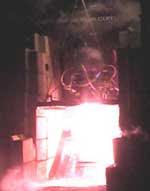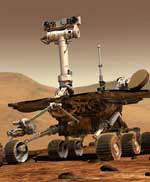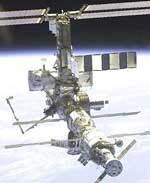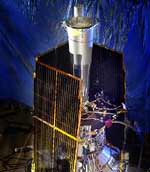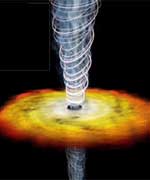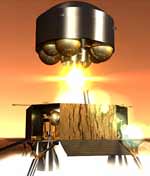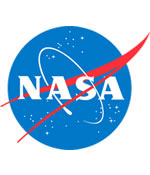
Image credit: NASA
NASA has set up a new safety advisory panel to replace the previous group that resigned back in September following the Columbia accident investigation report. The new ten members make up the NASA Aerospace Safety Advisory Panel, and will be an independent group responsible for safety oversight of NASA operations. This new safety board will play a key role in helping to ensure the space shuttles are safe to return to flight later in 2004.
NASA Administrator Sean O’Keefe today announced the new NASA Aerospace Safety Advisory Panel (ASAP), which includes nine distinguished members and a new charter. The initial meeting of the new panel is expected soon.
“The Columbia Accident Investigation Board report clearly indicated we need to get back to basics with our safety assessment,” said Administrator O’Keefe. “By recommitting ourselves to the original concept for the ASAP, we believe a stronger, more focused advisory panel will benefit the entire agency well beyond our Return to Flight efforts.”
The ASAP was originally chartered by Congress in 1967 after the tragic Apollo One fire, to act as an independent body to advise the NASA Administrator on safety issues regarding operations, missions and other agency initiatives. The new charter calls for the ASAP to be composed of recognized safety, management and engineering experts from industry, academia and other government agencies.
Over the years, administrative procedures were added to govern the conduct of the panel. These procedures have been revoked, and the new panel will have the opportunity to develop its agenda in concert with the oversight findings of the Columbia Accident Investigation Board.
“By drawing on and tasking the technical support of the NASA Engineering and Safety Center, the panel will have a deep capacity to conduct comprehensive, independent, external oversight of our safety systems, operations and culture. We welcome the members’ active participation in our efforts to emerge from the Columbia tragedy a smarter, stronger and safer agency dedicated to exploration,” said Administrator O’Keefe.
In late September 2003, 11 ASAP members and consultants resigned in the wake of the Columbia accident.
The new ASAP members are:
Rear Admiral Walt Cantrell, USN (Ret)
Former Commander, Space and Naval Warfare Systems Command
Member, NASA Stafford-Covey Return to Flight Task Group
Former NASA Aerospace Safety Advisory Panel member
Vice Admiral Joe Dyer, USN (Ret)
Former Commander, Naval Air Systems Command
General Manager, Military Systems Division, iRobot Corporation
Augustine Esogbue, Ph.D.
Professor and Director, Intelligent Systems & Controls Laboratory, School of
Industrial and Systems Engineering, Georgia Institute of Technology
Fellow, American Association for the Advancement of Science
Major General Rusty Gideon, USAF (Ret)
Former Commander, U.S. Air Force Safety Center, and USAF Chief of Safety
Former Director of Operations, Headquarters Air Force Materiel Command
Former Commander, Foreign Aerospace Science and Technology Center
Deborah Grubbe
DuPont Corporate Director — Safety and Health
Member, National Academy of Sciences
Former consultant, Columbia Accident Investigation Board
Rosemary O?Leary, J.D., Ph.D.
Professor of Public Administration and Political Science, Maxwell School of
Citizenship and Public Affairs at Syracuse University, New York
Member, NASA Stafford-Covey Return to Flight Task Group
John Marshall
Delta Airlines, Vice President Corporate Safety and Compliance, Atlanta
Co-chair, Commercial Aviation Safety Team
Board member, National Defense Transportation Association
Steve Wallace
Director, Office of Accident Investigation, Federal Aviation Administration
FAA representative to National Transportation Safety Board
Former Columbia Accident Investigation Board member
Rick Williams
Corporate Safety Director, Alcoa, New York
Former Director, Human Resources, Alcoa Primary Metals, Knoxville, Tenn.
Brigadier General Joseph Smith, USA — Ex-Officio Member
Director, U.S. Army Safety Center, Fort Rucker, Ala.
The new ASAP will begin with the original charter, signed by then-NASA Administrator James E. Webb. New provisions help assure an independent, long-term oversight of the agency’s safety policies and programs. Some of the revisions include:
* The new ASAP will report quarterly instead of annually
* The term for new members is two years, extendable to a maximum of six years in order to stagger terms of service and ensure a fresh perspective at regular intervals
* The new ASAP focuses on NASA’s safety and quality systems. ASAP will focus on industrial and systems safety, risk management, trend analysis and the management of these activities
“We’ve taken extra steps to ensure the independence of this panel,” said Associate Administrator for Safety and Mission Assurance Bryan O’Connor. “While the original law and the new charter allow for NASA members, none of the new members is a current or former agency employee or contractor.”
The new ASAP is also expected to play an important role in the ongoing safety assessment and review of the Space Shuttle program after Return to Flight. “We intend for the ASAP to oversee our implementation of the Columbia Accident Investigation Board’s recommendations long after the work of the Stafford-Covey Return to Flight Task Group is completed,” added Administrator O’Keefe. “Our intent is to institutionalize a renewed commitment to safety, and the panel will help us assure that we follow through on that objective.”
The new Aerospace Safety Advisory Panel charter and member biographies are available on the Internet, at:
http://www.nasa.gov/news/highlights/returntoflight.html
Original Source: NASA News Release
